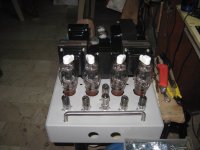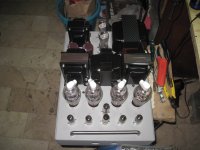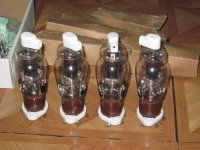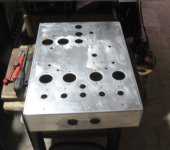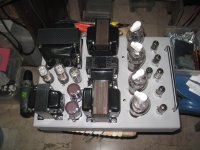starting my own version....operating points of the amp were given,
details of the CCS i can not find, but no biggie there as newer
depletion type mosfets become available, i will use them...
details of the CCS i can not find, but no biggie there as newer
depletion type mosfets become available, i will use them...
Attachments
Is this the version that you're working from?
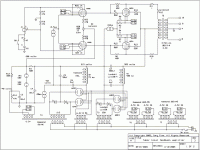
CCS schematic is here: https://web.archive.org/web/20101128120856/http://pimmlabs.com/web/self_bias.htm

CCS schematic is here: https://web.archive.org/web/20101128120856/http://pimmlabs.com/web/self_bias.htm
A really interesting design and a shame Gary's Tabor articles are no longer on the internet. I will watch your progress with GREAT interest!!!
yes, i was a frequent visitor to his site and read many of his work, time to put them to good use...
what is even more exciting is the arrival of depletion mosfets in the 500volt/6A specs...
yes Jerry, and i am mulling separate CCS for each cathodes of the 1624....
One of the strengths of Gary's design is the single CCS for both cathodes
It needs to stay in pure class A because the current is fixed, so use very efficient loudspeakers.
By using a CCS for each cathode you will have a completely different, and likely worse sounding, amplifier
I'd love to have Gary's work stored. The CCS impedance measurements, the SS amp designs( with the SS 'pentodes' ) and a long list of etc's...
cheers,
Douglas
many years ago, maybe eight, someone offered this amp to me to build, maybe it was you.....or maybe it was Garry himself......
Bud Purvine was generous enough to give me tips about the input traffo and the output traffo......i am building without the input traffo...
One of the strengths of Gary's design is the single CCS for both cathodes
It needs to stay in pure class A because the current is fixed, so use very efficient loudspeakers.
By using a CCS for each cathode you will have a completely different, and likely worse sounding, amplifier
well, i have not made up my mind yet...
in my builds, i have had good results with individual biasing of the output power tubes....
i would like to hear more comments before i decide finally...
would an option for paralleling the CCS so i can try it both ways be viable?
when i do an amp, i seldom stick to the theme 100%, i am sure others do it as well....
My stock contains some 25 1624's.
When finding time to build a Tabor and trying something different, I would try to replace the CCS in the output stage with a high L common choke (with the right DC resistance for biasing).
That would retain more of the character of this amplifier, and maybe give some more headroom.
Hey you are a winder isn't it?
When finding time to build a Tabor and trying something different, I would try to replace the CCS in the output stage with a high L common choke (with the right DC resistance for biasing).
That would retain more of the character of this amplifier, and maybe give some more headroom.
Hey you are a winder isn't it?
My first serious amp build was an 807 version of the Tabor. Sounded great and my current daddy amp is a version of the same design. Don't really think these designs can be beaten.
With regard to the single CCS vs one for each cathode, the way to do the seperate one is to bypass cathode to cathode. Use a back to back 1000uf + 1000uf between the cathodes. Let them float rather than referencing the node to earth - but make certain that they are rated at least at 100V to account for differences in biasing. Doing it this way should be the equal of the single one (if you believe that caps are relatively benign) and will avoid the need for bias adjustment.
Remember that this design has 100% local feedback around the finals so all the gain has to come from the front end.
Shoog
With regard to the single CCS vs one for each cathode, the way to do the seperate one is to bypass cathode to cathode. Use a back to back 1000uf + 1000uf between the cathodes. Let them float rather than referencing the node to earth - but make certain that they are rated at least at 100V to account for differences in biasing. Doing it this way should be the equal of the single one (if you believe that caps are relatively benign) and will avoid the need for bias adjustment.
Remember that this design has 100% local feedback around the finals so all the gain has to come from the front end.
Shoog
Last edited:
Remember that this design has 100% local feedback around the finals so all the gain has to come from the front end.
Shoog
Hmmm, are you sure?
Following quote from Positive Feedback describes the output stage:
The second stage of the Tabor is another differential amplifier—with a key difference; the local feedback resistors configure the amplifier stage as an inverting current to voltage amplifier. The input current working into the feedback resistors characterizes the voltage gain of the output stage.
Mathematically, the equation would be written as E=I*R where E is voltage, I is current and R is resistance. This is one of the variations of Ohm's law, one of the most basic fundamental building blocks of electronics. In the Tabor amplifier, the output stage gain is 136 volts per milliamp.
One of the interesting things about local feedback amplifiers is the local feedback works best if it is driven from a high impedance source. If the output impedance of the input stage is high enough, the output impedance of the output stage is equivalent to a cathode follower stage. Unlike a cathode follower stage, the local feedback stage has gain.
Positive FB got it a bit over simplified I think. The input stage's output Z is of course its plate resistance in || with the load resistor. To book-end the situation keeping the GP circuit in the output stage intact, we take an active device with gm of 2A/V, and a plate resistance of a MOhm. Given the 68k( IIRC ) plate load resistors currently attached to 6AU6's the output Z of the stage will be just a hair less than 68kOhm. It isn't this output Z that makes it work though, it is the plate resistance of the 6AU6( or my 2A/V substitute).
Take the E-Linear circuit, with B+ fed to the driver plates from a tap along the plate winding. The plate resistance of the amplifying device sets how much FB is delivered. Make it a 12B4 and FB will be substantially different than if an EL84 was attached in its place. Pete Millett wrote up this circuit for AudioXpress in SE with a D3A, while I was working with Emotive Audio and developing a PP circuit( Fred already had fine SE offerings...LOL ).
cheers,
Douglas
Take the E-Linear circuit, with B+ fed to the driver plates from a tap along the plate winding. The plate resistance of the amplifying device sets how much FB is delivered. Make it a 12B4 and FB will be substantially different than if an EL84 was attached in its place. Pete Millett wrote up this circuit for AudioXpress in SE with a D3A, while I was working with Emotive Audio and developing a PP circuit( Fred already had fine SE offerings...LOL ).
cheers,
Douglas
Hmmm, are you sure?
Following quote from Positive Feedback describes the output stage:
The second stage of the Tabor is another differential amplifier—with a key difference; the local feedback resistors configure the amplifier stage as an inverting current to voltage amplifier. The input current working into the feedback resistors characterizes the voltage gain of the output stage.
Mathematically, the equation would be written as E=I*R where E is voltage, I is current and R is resistance. This is one of the variations of Ohm's law, one of the most basic fundamental building blocks of electronics. In the Tabor amplifier, the output stage gain is 136 volts per milliamp.
One of the interesting things about local feedback amplifiers is the local feedback works best if it is driven from a high impedance source. If the output impedance of the input stage is high enough, the output impedance of the output stage is equivalent to a cathode follower stage. Unlike a cathode follower stage, the local feedback stage has gain.
Yes I am certain, there is usually a feedback load resistor in this arrangement which lowers the feedback ratio. In the Tabor this is the plate load resistor and the ratio is between this low value resistor and the pentode impedance - which is very high. This effectively creates a 100% feedback.
Gary Pimm uses high sensitivity speakers and so the low gain isn't an issue for him - it might be for others. Theoretically you should be able to get about 20watts of class A power out of this circuit - but you may well struggle to achieve the necessary gain to deliver that power. What is the design objective of the circuit - to achieve very high fidelity through very linear response and super low output impedance, it was never to achieve maximum power.
Shoog
Last edited:
My first serious amp build was an 807 version of the Tabor. Sounded great and my current daddy amp is a version of the same design. Don't really think these designs can be beaten.
With regard to the single CCS vs one for each cathode, the way to do the seperate one is to bypass cathode to cathode. Use a back to back 1000uf + 1000uf between the cathodes. Let them float rather than referencing the node to earth - but make certain that they are rated at least at 100V to account for differences in biasing. Doing it this way should be the equal of the single one (if you believe that caps are relatively benign) and will avoid the need for bias adjustment.
Remember that this design has 100% local feedback around the finals so all the gain has to come from the front end.
Shoog
thanks, like i said, i haven't made up my mind yet until i get the best advise.....
Thanks for the clarifications.
I remember that Gary brought this amp to the European Triode Festival in Germany 14 years ago, and it sounded very transparent, better in my ears than most SE amps there.
the very reason why i wanted to build this amp.....thanks for the fine review....
do you remember the speakers this amp was paired with?
What is the design objective of the circuit - to achieve very high fidelity through very linear response and super low output impedance, it was never to achieve maximum power.
exactly what i had in mind....thanks shoog...
- Status
- This old topic is closed. If you want to reopen this topic, contact a moderator using the "Report Post" button.
- Home
- Amplifiers
- Tubes / Valves
- Tony's TABOR amp clone wannabe build log.....
